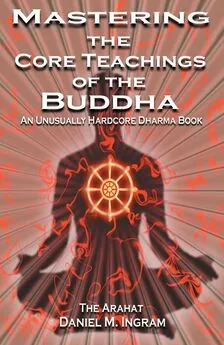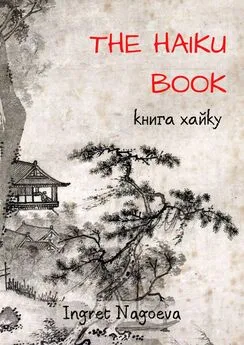Daniel Ingram - Mastering the Core Teachings of Buddha - An Unusually Hardcore Dharma Book
- Название:Mastering the Core Teachings of Buddha - An Unusually Hardcore Dharma Book
- Автор:
- Жанр:
- Издательство:Aeon Books
- Год:2009
- ISBN:9781904658405
- Рейтинг:
- Избранное:Добавить в избранное
-
Отзывы:
-
Ваша оценка:
Daniel Ingram - Mastering the Core Teachings of Buddha - An Unusually Hardcore Dharma Book краткое содержание
Mastering the Core Teachings of Buddha - An Unusually Hardcore Dharma Book - читать онлайн бесплатно полную версию (весь текст целиком)
Интервал:
Закладка:
Put another way, if you want to bring up your stuff, do concentration practices.
Third, concentration states can be a welcome and valid vacation from stress, providing periods of very deep relaxation and peace that can be an extremely important part of a sane, compassionate and healthy lifestyle. The Buddha highly praised those who had mastery of the concentration states, and this should serve as a reminder to those who underestimate their great value or erroneously feel that not enjoying one’s life is somehow “spiritual.” Fourth, concentration practices can help the insight practitioner stay somewhat more mentally stable and balanced as their old concepts of their existence are rent asunder by insight practice. However, if these states end up blocking this process by solidifying a sense of self as being anything or creating aversion to clearly experiencing suffering then they become a hindrance.
This is a very tricky balance. If a student clings to stability or fluidity they will surely not make progress in insight. However, if they plunge into the fast and harsh vibratory experiences of insight practice without the soothing effects of concentration practice to help them stay somewhat grounded, the student can be a bit like someone who has taken a small dose (or a big dose in the worst cases) of LSD or drunk way too much coffee. I spent the first five years of my practice giving only a moderate amount of attention to the samatha jhanas and I now realize that this was probably an error.
Sometimes spiritual openings can be extreme and dramatic, and being able to slow things down and calm down can sometimes be very useful and skillful if we have to deal with the world and deal with these openings at the same time. In short, if you want to gunk up your insight practice because you simply need to slow down so as to be able to get on with your life or not completely flip out, such as to study for medical school boards, etc., one way to do this is to indulge in concentration states. Coupling this with formal resolutions to not make progress in insight can be very effective.
135
Concentration vs. Insight
There are many concentration states, and they become progressively more refined as one masters them. A brief description of the concentration states follows. It is basically straight out of the standard texts and very accurate. Regardless of the tradition you are following, when you begin to get some mastery of its concentration practices you will go through these states in this order up to the level of your current ability, though some people can master skipping over jhanas.
The specific object of meditation may limit the level of jhana that can be attained, as well as color the experience of these states. Such details are spelled out in various canonical texts, such as The Vi
suddhimagga and the more readable but harder to find Vim
uttimagga .
Bhante Gunaratana’s The Jhanas, included in his more complete work The Path of Serenity and Insight, is a scholarly work on the subject, as is Nyanatiloka’s Path to Deliverance (published by the Buddhist Publication Society out of Sri Lanka).
Some of these texts (particularly the first two) go into long and sophisticated discussions about which posture and which object might be best suited to the individual proclivities of various types of people. It is unfortunate that this sort of information is not in common use today.
I suppose that a suit off the rack will work for most occasions, but there is something about one that has been tailor made. I am told that there are still a few monasteries that provide this sort of traditional training.
Unfortunately, this topic is way too complex to treat properly here, but those of you who are that serious about these subjects are highly advised to check out the original sources. They contain an astounding amount of powerful information but unfortunately make for fairly tedious reading.
Many traditions use the breath as the primary object initially and then shift to the qualities of the states themselves as the object of meditation when they arise and the concentration is strong. The quality of a jhana can either be “soft” or “hard” depending on how solidly one is in the state. In soft jhana, the qualities of that particular state are definitely recognizable in a way that is different from the ordinary experience of those qualities to the degree that we are confident we are in the altered state defined by those qualities.
136
Concentration vs. Insight
In really hard jhana, it feels as if our mind has been fused to those qualities and the object with super glue, as if we were nothing but a solid block or field of those qualities or that object, as if they and the object were the whole world with nothing else remaining. Getting into really
“hard” jhana states dramatically increases the beneficial effects of the practice, though it takes greater strength of concentration and usually requires more favorable practice conditions to do so. Taking the beneficial factors of the jhana solely as the object of concentration is helpful for this, as can be using an easily identified external object such as a candle flame or colored disk.
For detailed instructions in practices that use an external object, called “kasina” practices, the works listed above, particularly Bhante Gunaratana’s The Path of Serenity and Insight, provide such a good treatment of them that you should simply obtain and read those sources. However, the basic instructions are these: stabilize your concentration on an external object (kasina) until you can see the object with your eyes closed or when you are not looking at the object. Take that vision as the new object and stabilize your attention on it until your concentration is like a rock. From this foundation, you should be able to easily attain any of the states I am about to describe.
The basic pattern one goes through with these states is as follows.
First, one develops enough concentration to attain the jhana. Then the mind sees/feels the jhana, moves towards and into it, with almost all such state shifts occurring between the end of the out breath and the beginning of the new in breath, sometimes accompanied by the eyelids flickering. Then there is the honeymoon period, where the jhana is fresh but unsteady. Then there is the maturation period, when the jhana really comes into its own more solidly and shows its true glory. Then the faults of the jhana tend to become noticeable, as well as the proximity of the state to the state below it and the ease of falling into that lower state.
Next, the concentration deepens, and some sort of equanimity about the good and bad aspects of the jhana sets in. When the concentration grows strong enough and the current jhana is no longer desirable, the mind will naturally shift to the next higher jhana and the cycle goes around again within the limits of the humanly attainable states and your current skill level.
137
Concentration vs. Insight
138
Mastering the Core Teachings of the Buddha
21.THE CONCENTRATION STATES (SAMATHA JHANAS)
THE FIRST JHANA
The first jhana arises after the student has gained the ability to actually steady the mind on some object such as the breath, i.e. after a state called “access concentration,” meaning the level of concentration needed to access the first jhana or insight practice. Notice that if we are spinning lost in thought this is basically impossible. If you wish to attain this, I would try to stay as completely as possible with an object for perhaps 1 minute. When you can do this, try for 10 minutes. When you can do this, try for an hour. For instance, if you were using the breath as an object, try to be aware of every single breath at least in part for a full ten minutes, and then for an hour. This is definitely possible, and a reasonable goal. Try not paying too much attention to the individual sensations themselves, but conceptualize the breath as a coherent and continuous entity, with many different types of sensations all being thought of as being the breath. It is important to know that really getting into a sense of the breath as a continuous entity for 10 seconds will do you more good than being generally with the breath on and off for an hour.
Tune into the illusory smoothness of things by purposefully and calmly working with illusions of solidity or fluidity. There is a certain
“into it” quality which helps, sort of like really getting into a slow groove when playing an instrument, having sex, playing a sport, or just sinking into a well-deserved and warm bubble bath. Being in a silent and safe place is very helpful, as is giving yourself permission to relax, put the cares of the world behind you, and enjoy.
If you are using the breath as an object, you might try purposefully visualizing it as sweet, smooth waves or circles that are peaceful and welcome. Try breathing as if you were in a garden of fragrant roses and you wish to experience the fullness of their fragrance. Perhaps these tips will help illustrate the kind of non-resistant and peaceful presence that can help one attain these states. Tune into sensations in and around the primary object that feel good. Harbor no guilt, anxiety or fear related to the depths of pleasure, ease and well-being. The spiritual life need not
The Concentration States (Samatha Jhanas)
be some sort of relentless, austere grind, particularly when doing concentration practices.
As concentration improves, it is as though the mind “sees” the first jhana and grabs on to it. Having an idea of what you are looking for, i.e.
something enjoyable and steady, can be helpful for this. It has the five primary factors of applied and sustained effort or attention, rapture, happiness and concentration. Thus, it is great fun, feels good, but takes consistent effort to sustain. The attention is focused narrowly, as though one were looking at a small area of this page. This state can be quite a relief from the pain and discomfort of sitting meditation and can temporarily quiet the mind somewhat. As with all the concentration states, it is generally quite easy to concentrate on something that is very enjoyable. Thus, one’s concentration skills may improve rapidly and easily after attaining the first jhana and tend to basically flounder until one has attained the first jhana. Thus, attaining the first jhana is really, really important.
People tend to really like this state, and may cling to it for the rest of the retreat if on retreat, or cultivate it again and again in their sitting practice at home. It is a valuable attainment, as it serves as the minimum foundation for both insight and concentration practices. From the first jhana there are basically three things a meditator can do. They can either get stuck there (I know someone who spent some twenty years cultivating the first jhana in their daily practice and thinking this was insight practice), they can progress to the second jhana, or they can
investigate the first jhana and thus begin the progress of insight.
By “investigate” the state, I mean that they can direct their attention to breaking the illusion of the solidity of that state into its component individual sensations so that one can understand their true nature, i.e.
the Three Characteristics, as is done in insight practice with all objects.
Special attention must be paid to trying to experience the precise arising and passing of every individual sensation that makes up the state, particularly the primary beneficial factors of the state listed above.
While it is not actually possible to perceive the arising and passing of every single sensation or to even be mindful of every sensation, it is definitely possible to be clear about enough of them to get enlightened, and that is what matters. It is somewhat common for people to do this 140
Читать дальшеИнтервал:
Закладка:





![Дженнифер Гюнтер - The vagina book. Главная книга для тех, у кого есть этот орган [litres]](/books/1061538/dzhennifer-gyunter-the-vagina-book-glavnaya-kniga-dl.webp)




